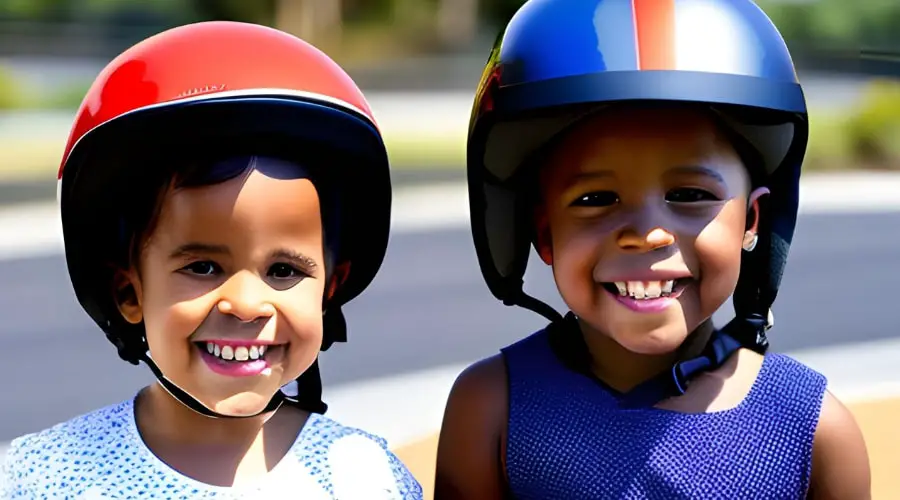Helmets play a vital role in protecting children from head injuries during various activities. Whether it’s biking, skating, or participating in sports, helmets are a crucial safety measure. This article explores the importance of helmet safety for kids and provides guidelines on how long children should wear helmets based on their age and other factors.

Section 1: Benefits of Wearing Helmets for Kids
Helmets offer several benefits when it comes to safeguarding children’s heads. They protect against concussions, skull fractures, and other serious injuries. Wearing a helmet significantly reduces the risk of traumatic brain injury and ensures that kids can enjoy their activities with peace of mind.
Section 2: Factors Determining the Duration of Helmet Use
Several factors influence how long children should wear helmets. Firstly, the specific activity they are engaged in determines the duration. For example, children should wear helmets while biking, skating, skateboarding, skiing, or participating in any activity with the risk of head injury. Additionally, the child’s age, level of coordination, and experience with the activity are crucial factors to consider.
Section 3: Age-Specific Guidelines for Helmet Use
Age-specific guidelines help parents and caregivers understand when to introduce and stop using helmets for their children. For toddlers and young children to begin helmets, use them as soon as they start riding tricycles or using ride-on toys. As they grow older, helmet use should continue during bicycle riding, roller skating, and skateboarding. Helmets are also necessary for teenagers involved in sports like football or hockey.
Section 4: Signs That a Child May Need a New Helmet
Regular helmet inspections are crucial to ensure their effectiveness. Signs that a child may need a new helmet include visible cracks or damage, loose or broken straps, or a helmet that no longer fits correctly. It’s important to replace helmets that have been involved in an accident, as the impact may have compromised their structural integrity.
Section 5: Tips for Ensuring Proper Helmet Fit
Proper helmet fit is essential to maximize protection. The helmet should sit level on the head, covering the forehead and not tilting backwards or forward. The straps should form a “V” shape under the ears, with the buckle comfortably fastened. Checking the fit periodically and adjusting as needed is crucial as children’s heads grow over time.
Section 6: Common Concerns and Misconceptions about Helmet Use
Some parents and children may have concerns or misconceptions regarding helmet use. Addressing these can help encourage proper helmet use. One common concern is that helmets may be uncomfortable or restrict vision. However, modern helmet designs prioritize comfort and visibility while maintaining safety standards.
Section 7: Teaching Kids about Helmet Safety
Educating children about helmet safety is essential for instilling good habits and ensuring their cooperation in wearing helmets. Here are some tips for teaching kids about helmet safety:
- Lead by example: Children are more likely to follow safety practices if they consistently see adults and older siblings wearing helmets. Make it a family rule always to wear helmets during relevant activities.
- Explain the importance: Talk to your child about why helmets are necessary for protecting their heads. Use simple and relatable language to help them understand the potential risks and how helmets provide a layer of protection.
- Make it fun: Incorporate helmet-wearing into playtime or make it a part of their routine. Let them choose helmets with their favourite colours or characters, turning them into an exciting accessory rather than a burden.
- Practice together: Show your child how to put on and adjust a helmet properly. Make sure they understand the correct positioning and how to fasten the straps. Practice taking the helmet on and off until they become comfortable doing it themselves.
- Reinforce positive behaviour: Praise and reward your child when they consistently wear their helmet without reminders. Positive reinforcement will help them develop a habit of prioritizing their safety.
Related: Why do Kids Always Wear Helmets?
Kids and Helmets: How to Get the Right Fit
Frequently Asked Questions:
How often should I replace my child’s helmet?
Replacing a child’s helmet every five years or immediately after a significant impact or accident is recommended. Regularly inspect the helmet for any signs of damage or wear and tear.
Can my child wear a helmet during sports activities?
Absolutely! Helmets are essential for protecting your child’s head during sports activities such as football, hockey, or skateboarding. Make sure to choose a helmet specifically designed for the sport.
Are all helmets equally safe for kids?
Not all helmets are created equal. Look for helmets that meet safety standards, such as CPSC or ASTM certification. These helmets undergo rigorous testing to ensure their effectiveness in protecting against head injuries.
What if my child refuses to wear a helmet?
It’s important to communicate the importance of helmet safety to your child and emphasize that it’s a non-negotiable rule. Try finding a helmet they love and involve them in the selection process to make it more appealing.
Can my child wear a bicycle helmet for other activities?
While bicycle helmets are designed specifically for biking, they can provide some protection for certain activities like roller skating or scootering. However, it’s best to use helmets specifically designed for each activity for optimal safety.
Conclusion
Ensuring that children wear helmets is crucial for their safety during activities with a head injury risk. By understanding the benefits of helmets, following age-specific guidelines, and teaching kids about helmet safety, we can create a culture of responsible helmet use. Remember, it’s not just about wearing a helmet for a certain period but encouraging lifelong helmet use to protect our children’s heads.
Helmetslab is a website that focuses on providing in-depth reviews and information about different types of helmets, including motorcycle helmets and others helmets. I am writing a post with proper research on the info that helps helmet users.

